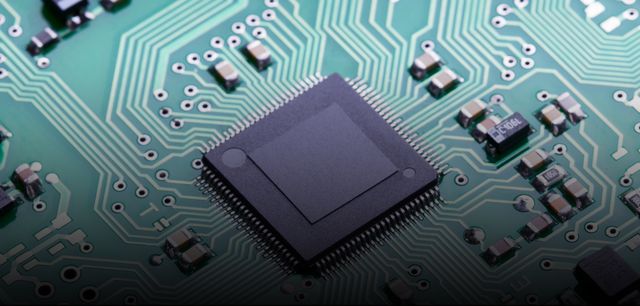1st June 2023
Semiconductors are found in smartphones, graphics cards and other consumer electronics. But they are also an indispensable component in wind turbines, solar panels, heat pumps and cars. Due to bottlenecks in chip supply, especially during the coronavirus crisis, various car manufacturers had to temporarily scale back or even pause their production. To date, the chips have mainly come from Asia. The EU now wants to boost production in Europe.
Big event in Dresden. At the virtual ground-breaking ceremony for Infineon's new chip factory, Mayor Dirk Hilbert and Saxony’s Prime Minister Michael Kretschmer, accompanied by German Chancellor Olaf Scholz and EU Commission President Ursula von der Leyen, held silver shovels up to the cameras. The plan is for the first chips from the so-called “Smart Power Fab” to be delivered and used, for example, in chargers, engine control systems for cars, data centres and the networked devices of the Internet of Things as of autumn 2026.
Dresden is already one of Infineon’s largest development and production sites. 3,250 people are currently working there for the Munich-based chip company. The stated aim is for the Smart Power Fab to create 1,000 additional jobs and make Dresden one of the leading semiconductor locations in Europe. The semiconductor manufacturer is investing five billion euros in the new plant. According to the company’s own statements, this is the largest single investment in the company’s history, for which the group can also rely on subsidies from the state. Both German and European politicians have high hopes for the expansion of domestic semiconductor production. “Dresden is one of Europe’s digital beacons,” said EU Commission President von der Leyen. The aim is to secure the technological sovereignty of the EU. After all, any disruption to the semiconductor trade would hit the European single market hard, von der Leyen warned.
The chip crisis is not over yet
The so-called chip crisis, which culminated during the coronavirus pandemic and forced various European carmakers into production bottlenecks, showed the kind of effect that such disruption can have. One of the reasons is that, to keep warehousing costs down, car manufacturers buy their chips just in time, i.e., in time to meet the demand at any given point. And during the pandemic, many carmakers cancelled their chip supply contracts on a massive scale, explains Timo Bartkewitz of TÜVIT. “Ultimately, however, global demand for passenger cars didn’t fall as expected, and semiconductor manufacturers went looking for other customers in the meantime,” says the expert. The situation on the global markets has now eased somewhat. However, unrestricted availability is still not in prospect. For example, the German Association of the Automotive Industry (VDA) expects a decline in the global production of vehicles of 20 percent by 2026 due to the chip shortage.
Growing tensions between China and Taiwan could also jeopardise semiconductor supplies in the future, warns EU Council President von der Leyen. Taiwan is currently considered the world’s largest semiconductor producer; China is in fourth place and, together with the island state, accounts for 36 percent of global production. “If there were to be stricter trade sanctions or even armed conflict between China and Taiwan, this could have serious consequences for chip supply in Europe,” says Bartkewitz from TÜVIT. This is one of the reasons why, from the point of view of EU policy, more large-scale semiconductor production is needed in Europe.
About Timo Bartkewicz
Dr. Timo Bartkewitz is an expert in hardware and embedded security at TÜVIT. In his day-to-day work in the field of IT security, the graduate electrical and information engineer scrutinises chips on debit cards and IDs to determine how hack- and manipulation-proof they are.
European Chips Act
Infineon expects to receive one billion euros in government funding for its five-billion-euro project in Dresden. The legal basis for the subsidy is the “European Chips Act”, which was passed in April. The EU wants to mobilise a total of 43 billion euros in public and private investment, doubling the global production share of semiconductors in Europe to 20 percent by 2030. Since demand is also expected to double by then, current production capacities on the continent would have to be quadrupled to meet it, according to EU Commission President von der Leyen.
It remains to be seen whether the EU will be able to compete internationally, even with these subsidies. This is because the US is investing 52 billion dollars in the domestic semiconductor industry care of the so-called “Chips Act for America”. Samsung plans to invest the equivalent of 230 billion dollars in its own chip production in South Korea by 2042. China, on the other hand, is planning an investment programme of 143 billion euros in response to production in the United States, according to information from the Reuters news agency.
Despite the fierce global competition, the EU programme is also attracting companies. A total of more than 100 billion euros in investment was announced after the plans were publicised in 2022, an EU representative told the German news and current affairs programme, Tagesschau.
At the virtual groundbreaking ceremony of the semiconductor manufacturer Infineon in Dresden, the political elite also showed their colors.
Intel in Magdeburg
The US chip manufacturer Intel, for example, is planning a plant in Magdeburg, where processors and graphics chips are to be produced from 2027. 3,000 jobs are to be created in Magdeburg itself, with more staff also being taken on by suppliers. Intel plans to invest 17 billion euros in the new plant and a total of 80 billion euros in Europe over the next ten years. However, the decision in favour of Magdeburg is not yet done and dusted: According to media reports, Intel is pushing for higher government funding. The promised 6.8 billion euros will not be enough, the company claims. According to Intel, ten billion euros are now needed – because of increased costs for energy, logistics and the construction work itself. In return, the German government has apparently demanded a compromise: In return for higher subsidies, Intel will also have to increase its planned investments.
Technology product: Semiconductors enable complex electronic circuits and are the starting material of computer chips.
Wolfspeed in Saarland and Bavaria
Wolfspeed, in Ensdorf, Saarland, is one step further ahead: The US company is going to build a chip factory here for 2.75 billion euros. From 2027, around 600 employees are expected to produce silicon carbide semiconductors for use in energy and industrial plants. The advantage of Silicon carbide chips is that “they tolerate higher voltages and temperatures and are more powerful and more energy-efficient than conventional silicon chips,” explains Bartkewitz from TÜVIT. These features mean that they can increase the range and charging speed of electric cars.
Wolfspeed expects to receive funding of around 20 percent of the total investment costs for the new factory. Supplier ZF is investing in the plant, both financially and in terms of its know-how, with the aim of creating the world’s most modern and largest factory for silicon carbide semiconductors. The two companies are also planning a research centre for semiconductor development near Nuremberg, which in turn will be funded by the German government and the state of Bavaria.
Wolfspeed’s focus on higher-priced high-end chips in Europe makes perfect sense for Timo Bartkewitz of TÜVIT. After all, Asia has lower labour costs and has already developed production capacities for the mass production of low-cost semiconductors. “Europe’s strengths, on the other hand, still lie in research,” says the expert. “High-end chips are therefore an obvious step, as new findings and developments can be most directly put to good use here.”
What is a semiconductor?
Copper, silver and other metals conduct electricity in every situation. Semiconductors, on the other hand, are materials that possess the properties of both conductors and non-conductors: At low temperatures, for example, they are non-conductors; whereas, at higher temperatures or when targeted with light irradiation they conduct electricity. Semiconductors suitable for chips do not occur in nature, explains Timo Bartkewitz from TÜVIT. “They’re a purely technological product designed by people to meet the needs of different customers in different situations.” Semiconductors are an indispensable ingredient in complex electronic circuits and the basic material for computer chips. Which is why the two terms are often used interchangeably. Chips are mostly made from the semiconductor silicon to which Silicon Valley owes its name.
Also interesting
 Adobe Stock | Denis Yevtekhov
Adobe Stock | Denis YevtekhovThe forensic IT experts
On the trail of the hackers.
Read more





